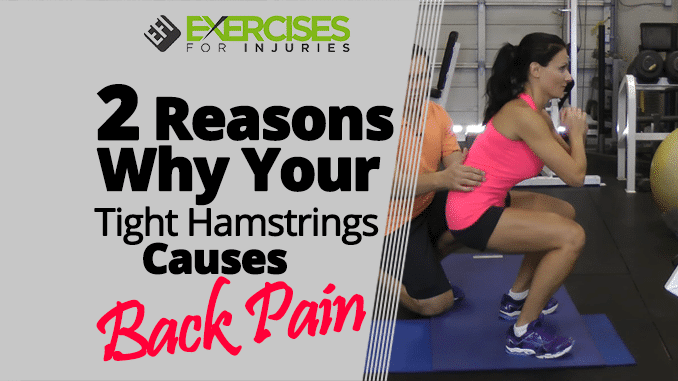Hey, I was looking back at some of the YouTube videos that I’ve done. I came across a video about hamstrings and back pain where I answered a great question from an Exercise For Injuries loyal subscriber. So, I dug it up and am sharing it with you today.
If you have tight hamstrings, check out the article and video below. Watch out for new YouTube videos as I head off to film more videos for you.
Enjoy.
CLICK HERE to watch the YouTube video.
The hamstrings are one of the most important muscles in your body. They’re also known as the “good” muscle group because they help you move efficiently and with less tension on your back. They also play an important role in preventing low back pain!
Tight hamstrings, however, can cause low back pain and other conditions.
What are Hamstrings?
Your hamstring muscles are voluntary and involve moving your leg. You have three at the back of your thigh; you use these muscles to walk, climb stairs, do squats and perform many other movements with your legs. The hamstring muscle is very susceptible to injury. This is especially true in athletes that run or sprint when suddenly stopping, slowing down, or changing direction puts a lot of strain on these muscles.
A pulled hamstring occurs when running too fast while extending one’s leg due to overstraining it during intense physical activity like speedrunning. A possible cause for such an occurrence could be excessive stretching of the hamstrings (since they’re used as stabilizing structures).
There are three different types of muscles in your lower leg: hamstring, quadriceps, and calves. The hamstrings are the most common muscle to become injured. Stretching, warming up, and not pushing through pain in your hip, knee, or legs are important when doing any physical activity so you don’t get an injury from them, like a hamstring strain.
Hamstring functions include the following:
- Bending the knee joint
- Extending the hip joint
- Rotating the hip joint
What are the Causes of Tight Hamstrings?
Tightness in the hamstrings is common but can occur after exercise or other intense activities. The goal of many exercises for hamstring tightness is to increase muscle strength and stretch out muscles before engaging in strenuous activities such as sports like soccer.
To avoid injury, it’s important to warm up and cool down afterward when completing any activity that significantly strains the body. Not only does this prevent injuries from occurring, but it also helps reduce pain so that you can do your daily workout more often!
Other causes of tight hamstrings:
- Weakness
- Injury
- Overuse
- Not enough movement
- Genetic
- Injury
Why do Tight Hamstrings Cause Back Pain?
The hamstrings are the muscles located at the back of your thighs. They help to keep you standing upright and enable you to swing your leg forward in a large arc, jump or run. This is why they’re so important! If an issue with these muscles causes pain when walking upstairs, and if surgery hasn’t helped, physical therapy can be valuable for recovery and prevention.
People with tight hamstrings often experience a lot of pain in their lower back, hip, and peripheral joints. Often this can also be caused by people putting too much strain on the lumbar spine. One thing to remember is that when you’re sitting at your desk or driving behind the wheel all day with bad posture, it will likely cause problems for your health and well-being down the line.
Prevention for Tighter Hamstrings
Tight hamstrings are usually not a cause for concern. In most cases, they are treatable with stretches and exercises.
However, in some instances, the tightness may become severe or painful enough to warrant treatment from a medical professional such as physical therapy or massage therapist.
When pain is present during exercise, it should be reported immediately to your doctor to determine what action to take.
Other treatments:
- Use of foam roller in stretching
- Consult with a physical therapist
- Massage therapy
- Using hot or cold packs
Here are other causes why your tight hamstrings cause back pain:
1. Changes in the Position of the Pelvis and Back When Standing
When you are standing, your pelvis and back should normally be in their normal positions. If you have tight hamstrings, the muscles will shorten, changing the position of the pelvis and the back. The curve in the back is normal. Losing that curve puts unnecessary stress on the spine, increasing the risk of irritation, pain, and injury. We have to loosen up the hamstrings so the spine or lower back will be in a normal curve position.
2. Pelvis Is Tucked and Back Flattens Out During Squats
When you are in a squatting movement, tight hamstrings will pull your pelvis and change the position of your lower back. You will find it difficult to do the movement. The pelvis is tilted back (tucked) if your hamstring is tight. The tightness will move your pelvis back and flatten out your back. The flattening out of your back increases the risk of irritation, injury, and pain. We have to work on loosening up the hamstrings and lengthening the muscles.
Many people experience back pain from tight hamstrings. You may feel like you’re doing everything right, but your muscles are causing you more harm than good. If you find yourself struggling with back pain, try those mentioned above.
Take care!
Rick Kaselj, MS
If you want to get rid of your stubborn hamstring injury once and for all, click here to check out the Hamstring Injury Solution program.

